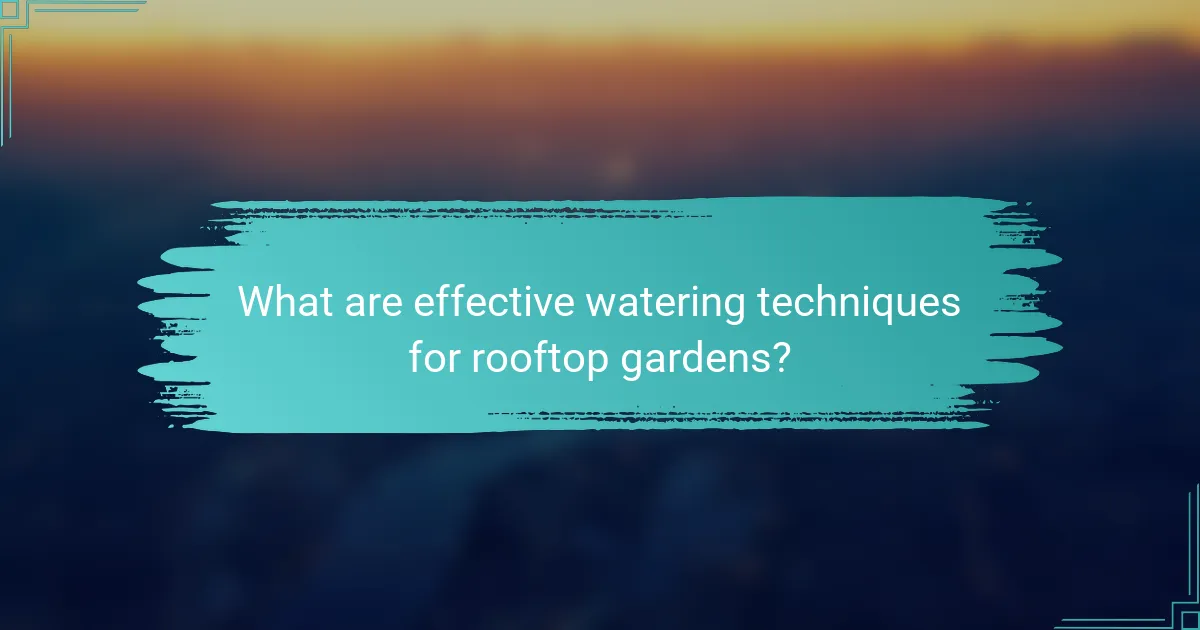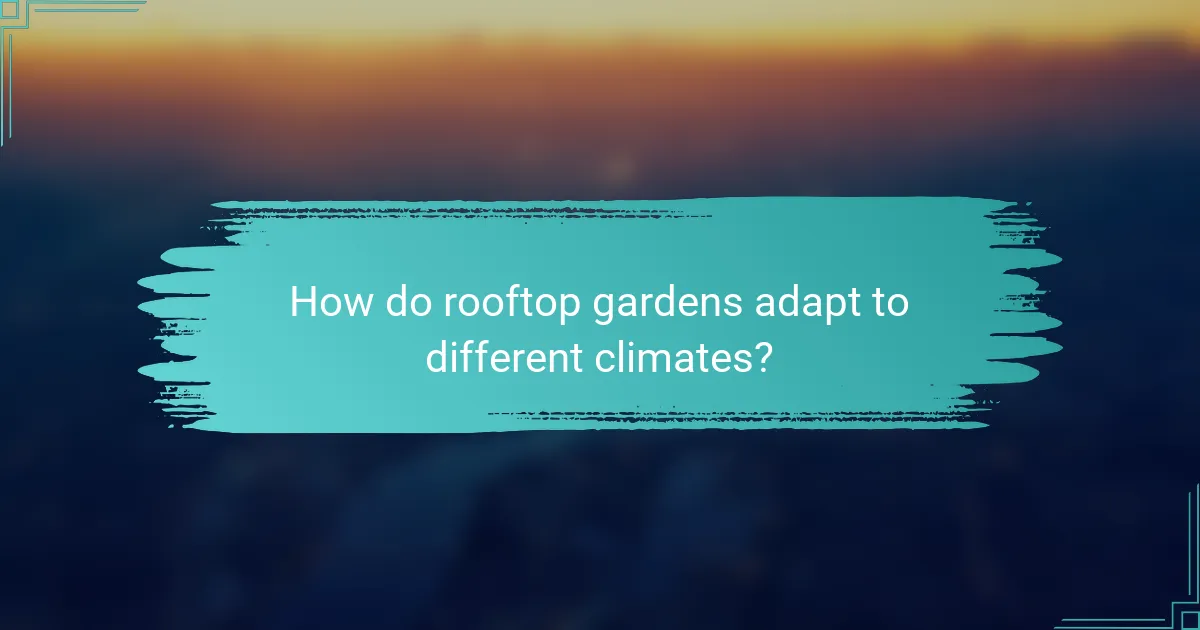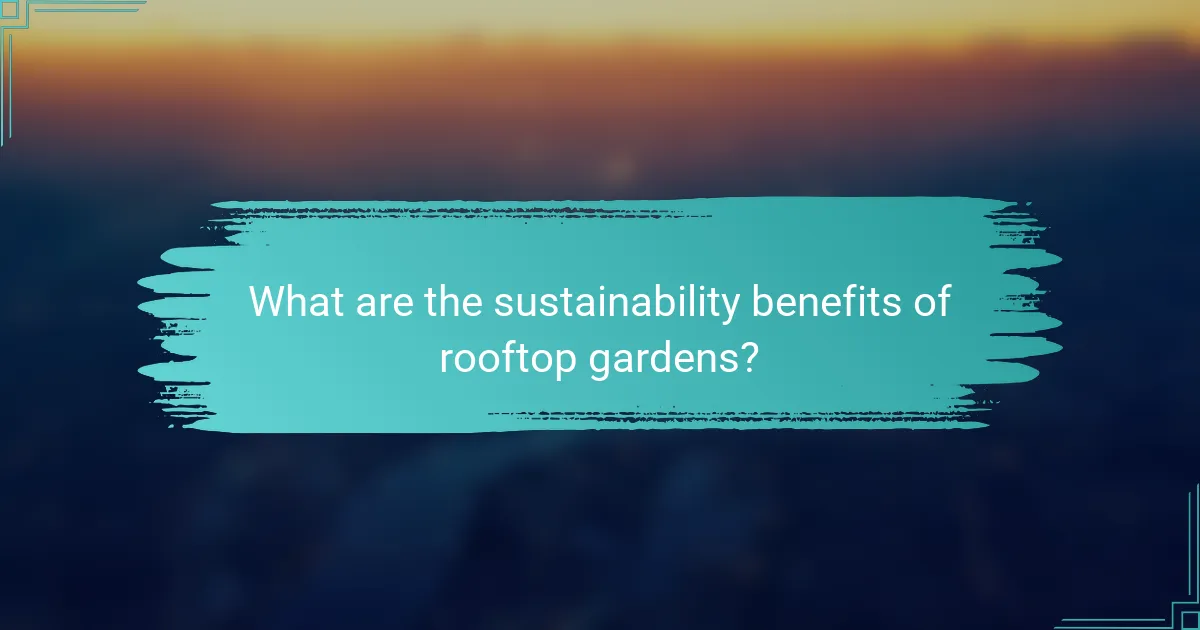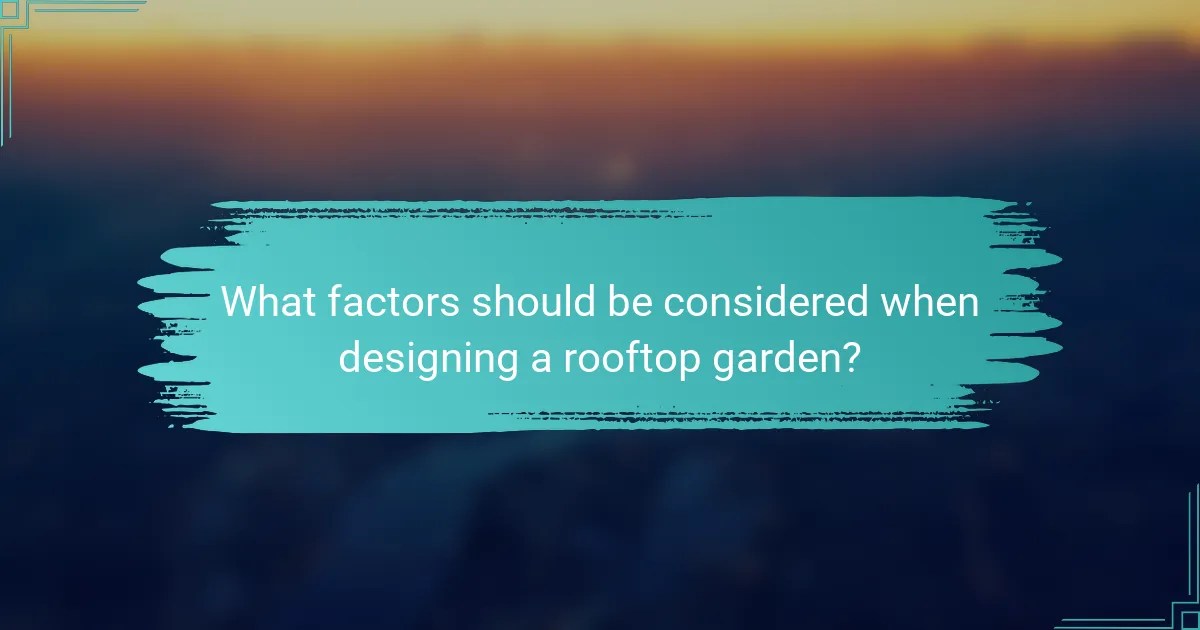Rooftop gardens are innovative solutions that enhance urban environments by promoting sustainability and improving plant health through effective watering techniques. By utilizing methods like drip irrigation and rainwater harvesting, these gardens can thrive in various climates while conserving water. Additionally, strategic plant selection and climate management contribute to their resilience and ecological benefits, making them vital for urban green spaces.

What are effective watering techniques for rooftop gardens?
Effective watering techniques for rooftop gardens are crucial for maintaining plant health and conserving water. Methods such as drip irrigation, soaker hoses, and rainwater harvesting can optimize water usage while adapting to the unique challenges of elevated gardening.
Drip irrigation systems
Drip irrigation systems deliver water directly to the roots of plants through a network of tubes and emitters. This method minimizes evaporation and runoff, making it highly efficient for rooftop gardens. Consider using a timer to automate watering and ensure consistent moisture levels.
When installing a drip system, choose emitters based on the water needs of your plants, and regularly check for clogs to maintain optimal performance. A well-designed system can reduce water usage by up to 50% compared to traditional methods.
Soaker hoses
Soaker hoses are porous hoses that allow water to seep out slowly along their length, providing even moisture to the soil. They are easy to install and can be laid out in a variety of configurations to suit different garden layouts. This method is particularly useful for larger areas or rows of plants.
To maximize efficiency, cover the soaker hoses with mulch to reduce evaporation and help retain soil moisture. Regularly inspect the hoses for leaks or blockages to ensure they function effectively.
Rainwater harvesting
Rainwater harvesting involves collecting and storing rainwater for irrigation purposes. This sustainable technique can significantly reduce water costs and reliance on municipal supplies. Install a rain barrel or cistern to capture runoff from your rooftop.
Ensure that your collection system is properly filtered to prevent debris from clogging the storage tank. Depending on your local regulations, you may need to follow specific guidelines for rainwater harvesting to ensure safety and compliance.
Automated watering schedules
Automated watering schedules allow you to program watering times and durations, ensuring plants receive consistent moisture without manual effort. This is particularly beneficial for busy gardeners or those managing multiple rooftop gardens.
Use smart irrigation controllers that adjust schedules based on weather conditions, helping to conserve water. Regularly monitor soil moisture levels to fine-tune your settings and avoid overwatering.
Hand watering methods
Hand watering is a straightforward method that allows for precise control over how much water each plant receives. Use a watering can or hose with a spray nozzle to target specific areas, which can be beneficial for delicate plants or seedlings.
To avoid water waste, water early in the morning or late in the evening when evaporation rates are lower. Pay attention to the soil’s moisture level and adjust your watering frequency based on seasonal changes and plant needs.

How do rooftop gardens adapt to different climates?
Rooftop gardens adapt to various climates by selecting appropriate plant species, managing microclimates, and employing insulation and shading techniques. These strategies help optimize plant growth and sustainability regardless of environmental challenges.
Heat-resistant plant selection
Choosing heat-resistant plants is crucial for rooftop gardens in warm climates. Varieties such as succulents, native grasses, and Mediterranean herbs thrive in high temperatures and require less water. This selection not only conserves resources but also reduces maintenance efforts.
When selecting plants, consider local climate conditions and seasonal temperature fluctuations. For example, in areas with extreme heat, opting for drought-tolerant species can significantly enhance garden resilience.
Microclimate management
Microclimate management involves creating localized conditions that can support plant growth despite broader climate challenges. This can be achieved through strategic placement of plants, using windbreaks, and incorporating water features to moderate temperature. For instance, taller plants can provide shade for smaller ones, reducing heat stress.
Monitoring factors like sunlight exposure, wind patterns, and humidity levels can help gardeners make informed decisions about plant placement and care. Utilizing these insights can lead to a more productive and sustainable rooftop garden.
Insulation and shading techniques
Insulation and shading techniques are essential for protecting rooftop gardens from extreme weather. Installing shade cloths or using pergolas can help reduce direct sunlight exposure, preventing overheating. Additionally, insulating materials can be used in the garden’s construction to maintain stable temperatures.
Consider using reflective materials or green roofs to enhance insulation. These methods not only protect plants but also contribute to energy efficiency in the building, making the rooftop garden a sustainable feature.
Seasonal planting strategies
Implementing seasonal planting strategies allows rooftop gardens to adapt to changing climates throughout the year. By rotating crops and selecting plants suited for each season, gardeners can maximize yield and minimize pest issues. For example, cool-season crops like lettuce and peas can be planted in early spring, while heat-loving plants like tomatoes can be introduced in summer.
Planning for seasonal changes also involves understanding local frost dates and rainfall patterns. This knowledge helps in timing plantings effectively, ensuring that the garden remains productive and resilient across different weather conditions.

What are the sustainability benefits of rooftop gardens?
Rooftop gardens offer numerous sustainability benefits, including energy efficiency, improved water management, and enhanced urban ecosystems. These gardens help mitigate environmental challenges while providing green spaces in densely populated areas.
Urban heat island reduction
Rooftop gardens significantly reduce the urban heat island effect, which occurs when urban areas become warmer than their rural surroundings due to human activities. By providing vegetation and soil, these gardens absorb sunlight and cool the air through evapotranspiration, leading to lower temperatures.
Implementing rooftop gardens can lower surface temperatures by several degrees, which helps reduce the need for air conditioning in nearby buildings. This not only decreases energy consumption but also lowers greenhouse gas emissions.
Stormwater management
Rooftop gardens play a crucial role in stormwater management by absorbing rainwater, which reduces runoff and minimizes the risk of flooding. The soil and plants retain water, allowing it to evaporate slowly, which helps manage excess water during heavy rainfall.
By capturing rainwater, rooftop gardens can reduce the burden on municipal drainage systems. This is particularly beneficial in urban areas where impermeable surfaces dominate, leading to increased flooding and water pollution.
Improved air quality
Rooftop gardens contribute to improved air quality by filtering pollutants and absorbing carbon dioxide. Plants in these gardens can capture particulate matter and other harmful substances, leading to cleaner air in urban environments.
Additionally, the increased greenery helps to produce oxygen, enhancing the overall air quality. This is especially important in cities where air pollution levels can be a significant health concern.
Increased biodiversity
Rooftop gardens promote increased biodiversity by providing habitats for various species, including birds, insects, and other wildlife. These green spaces can serve as vital refuges in urban areas where natural habitats are scarce.
By incorporating native plants, rooftop gardens can attract pollinators and support local ecosystems, contributing to a healthier urban environment. This biodiversity not only enhances the aesthetic value of cities but also supports ecological resilience.

What factors should be considered when designing a rooftop garden?
When designing a rooftop garden, key factors include the building’s structural capacity, sunlight availability, and ease of access for maintenance. Each of these elements plays a crucial role in ensuring the garden’s success and sustainability.
Weight limitations of the building
Understanding the weight limitations of the building is essential when planning a rooftop garden. Most rooftops can support a certain load, typically ranging from 15 to 25 pounds per square foot, depending on the structure. It’s vital to consult with a structural engineer to assess the maximum weight capacity before adding soil, plants, and other materials.
Consider using lightweight soil alternatives and selecting plants that require less soil volume to minimize weight. Container gardens can also be a practical solution, allowing for flexibility and easier management of weight distribution.
Sunlight exposure
Sunlight exposure significantly impacts plant selection and garden design. Assess the roof’s orientation and any potential shading from nearby buildings or trees. Ideally, a rooftop garden should receive at least 6 hours of direct sunlight daily for optimal plant growth.
To maximize sunlight, consider installing reflective surfaces or using trellises to elevate plants. If certain areas receive less light, choose shade-tolerant plants that can thrive in those conditions.
Accessibility for maintenance
Accessibility is crucial for the ongoing maintenance of a rooftop garden. Ensure that pathways are wide enough for easy movement and that all areas are reachable without excessive effort. This includes considering the placement of plants, irrigation systems, and tools.
Plan for regular maintenance tasks such as watering, pruning, and harvesting by creating a layout that allows for efficient access. Incorporating features like raised beds can also help reduce bending and make care easier for gardeners.
